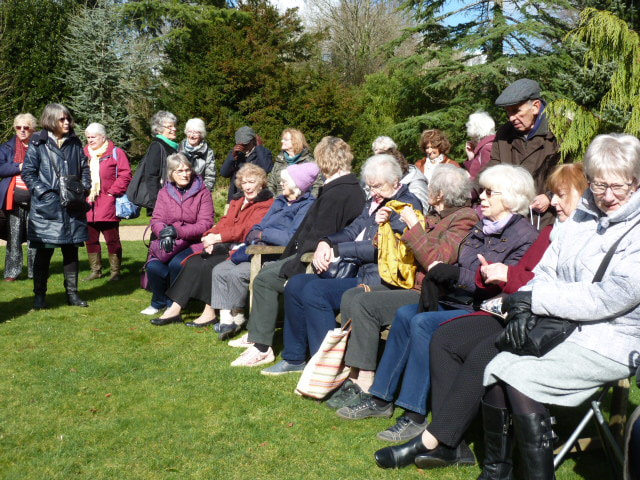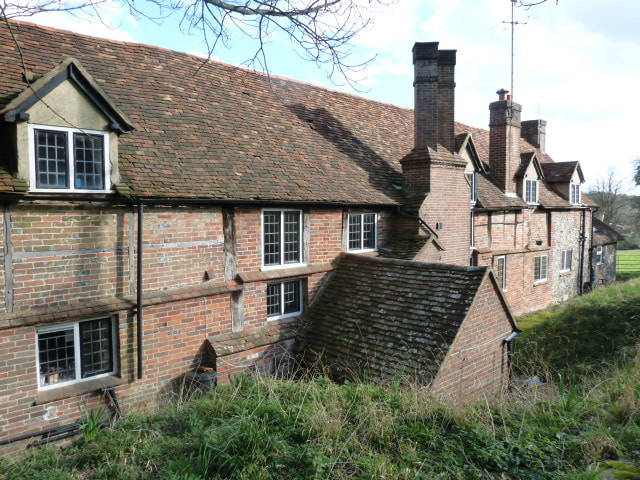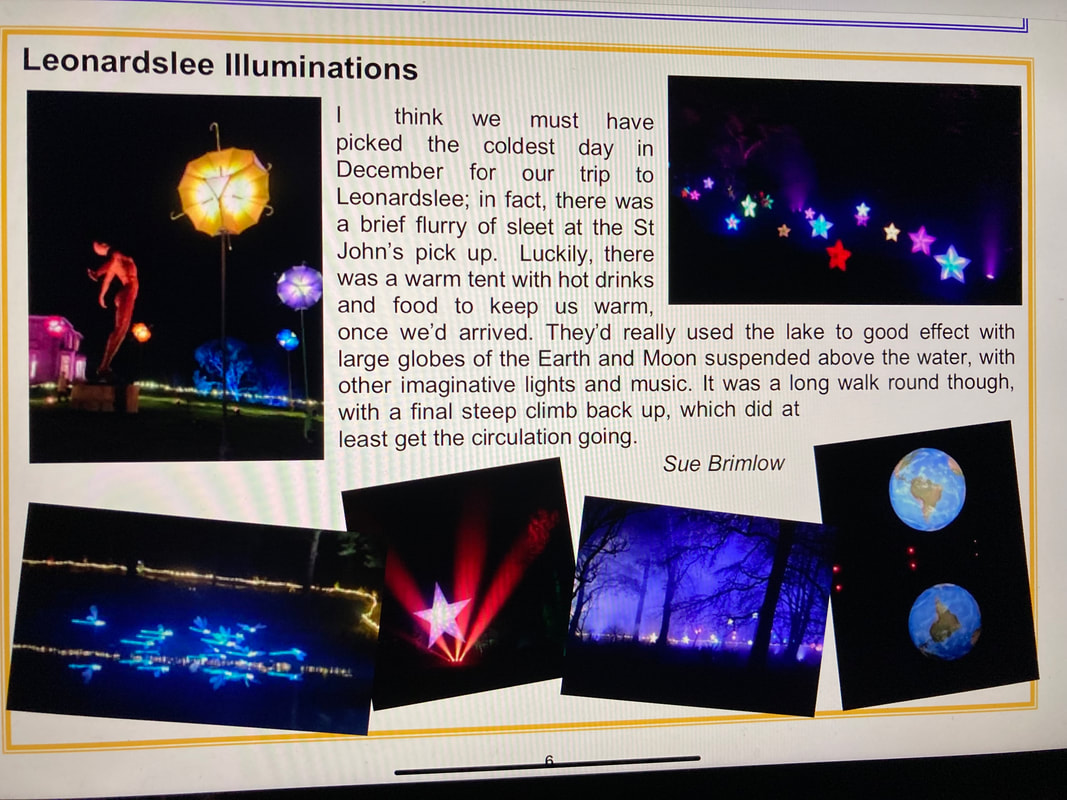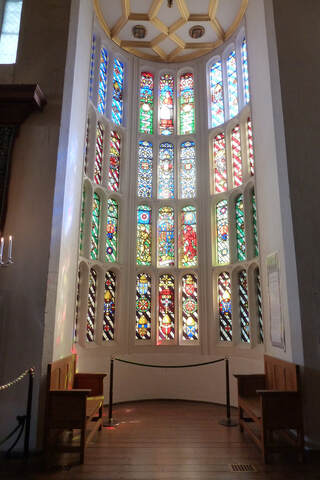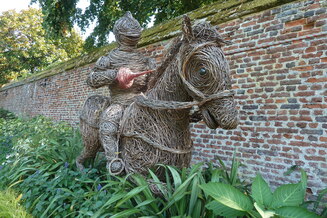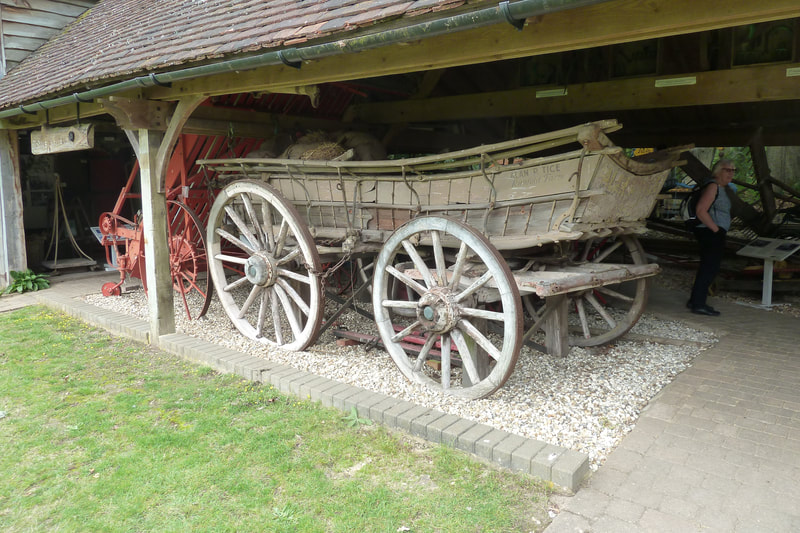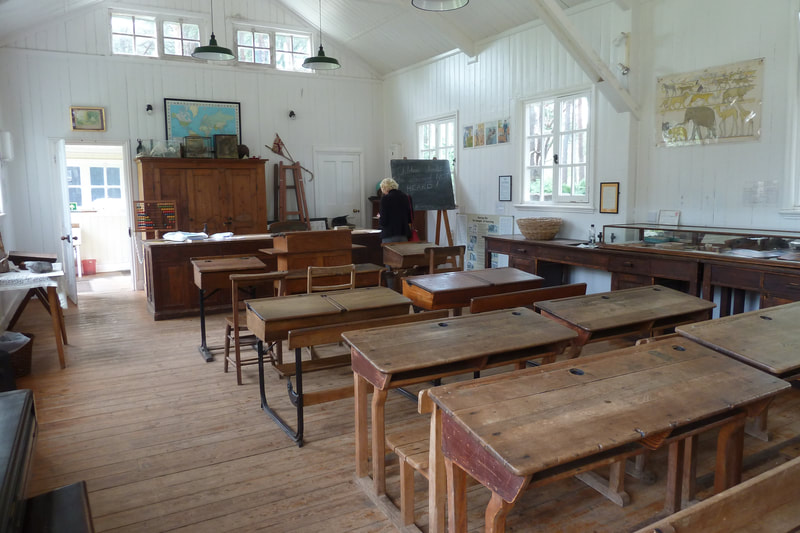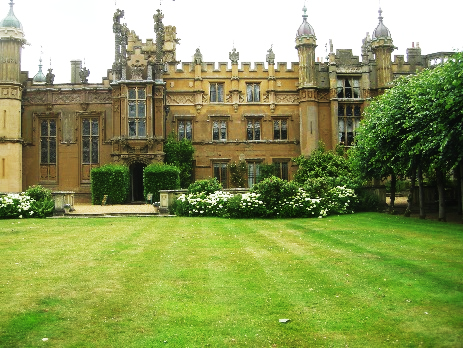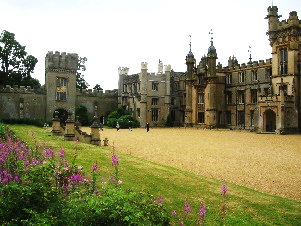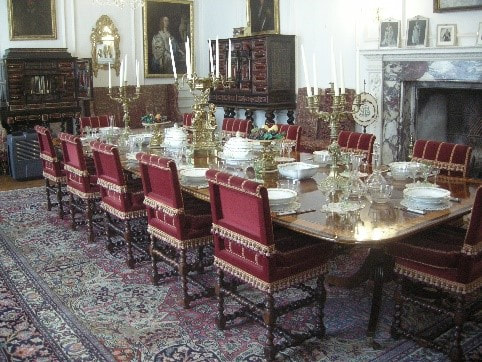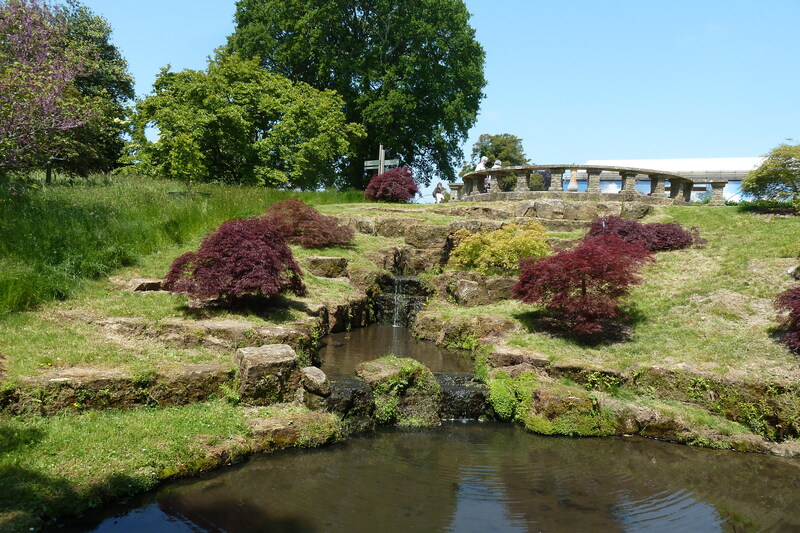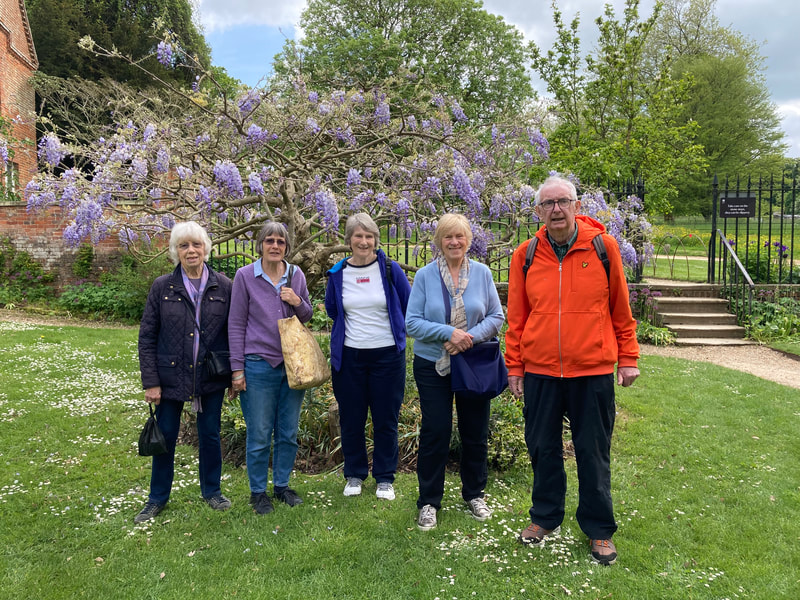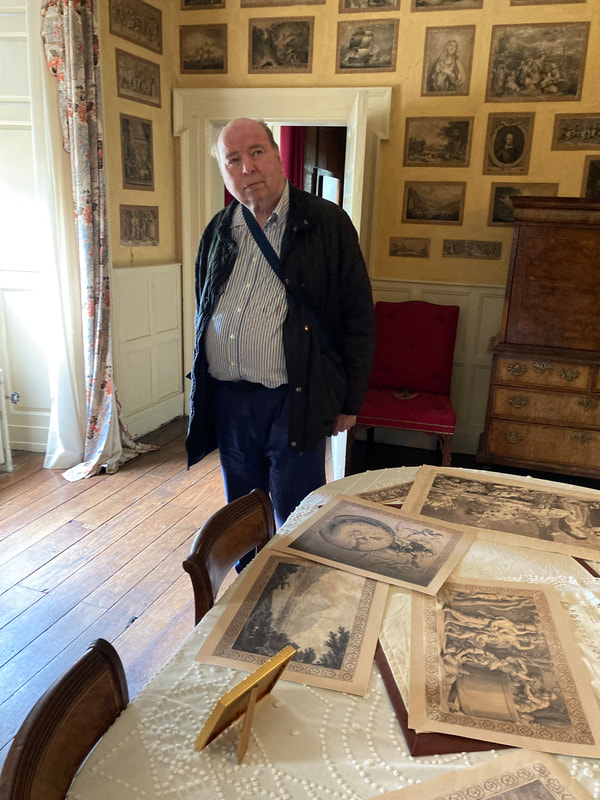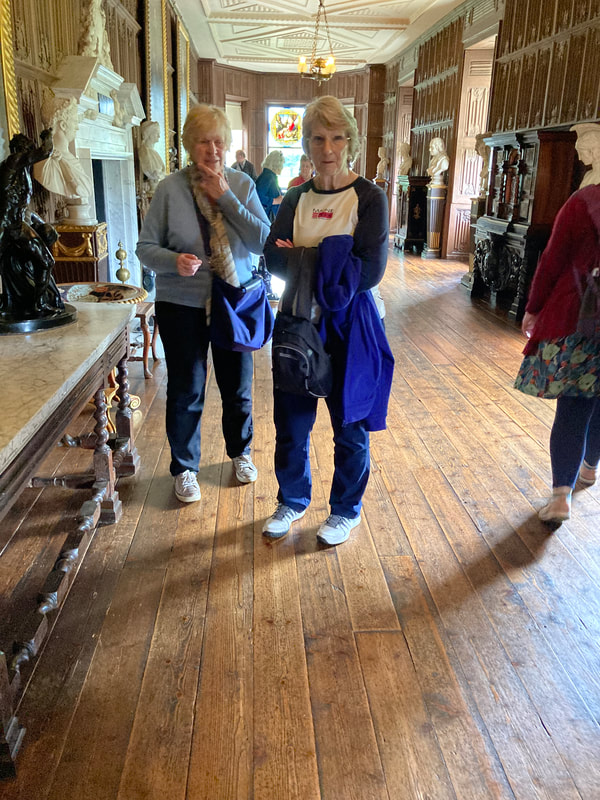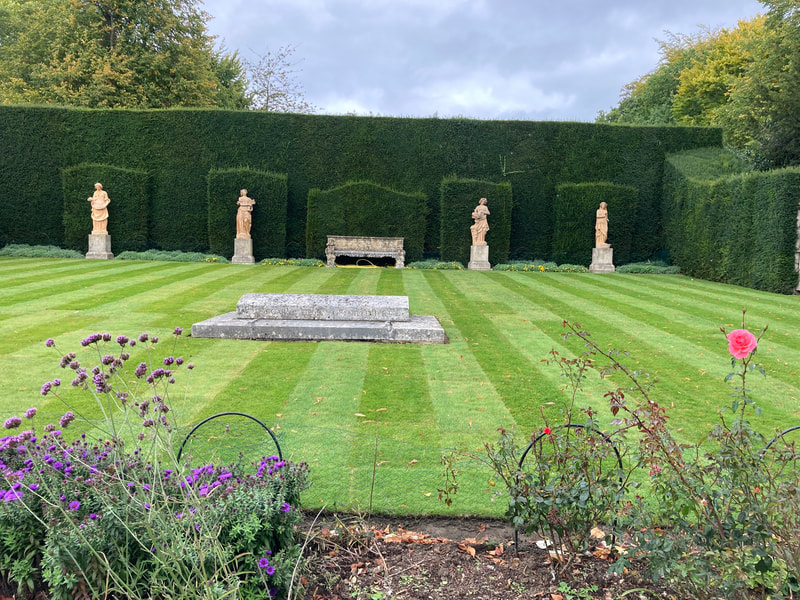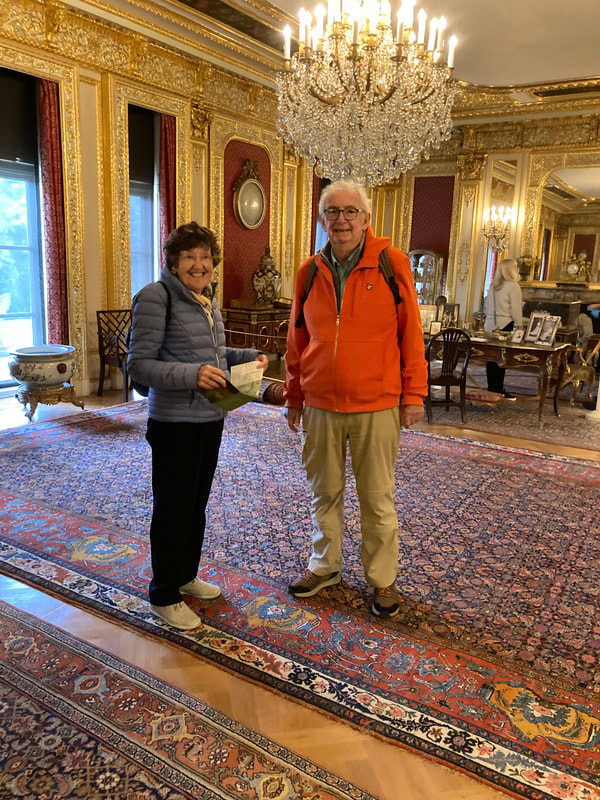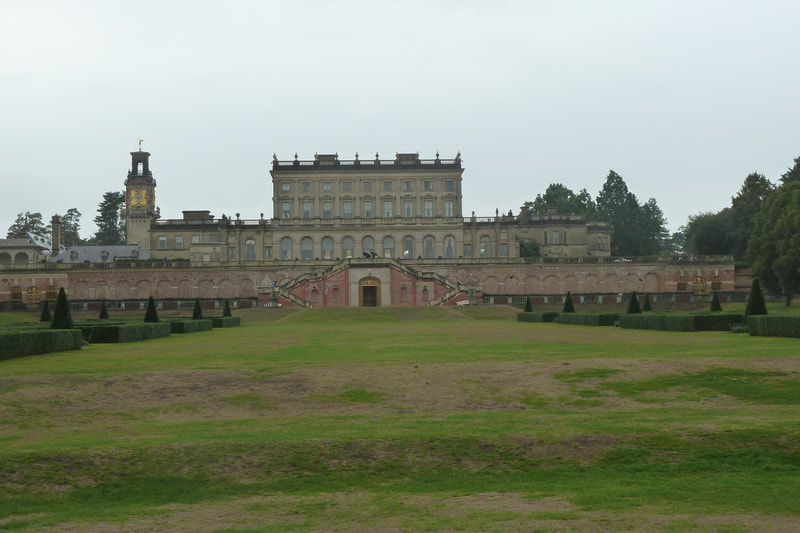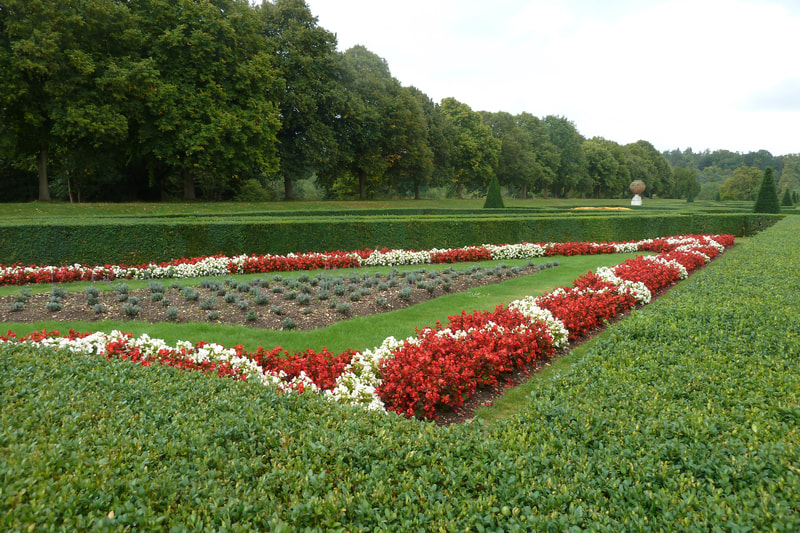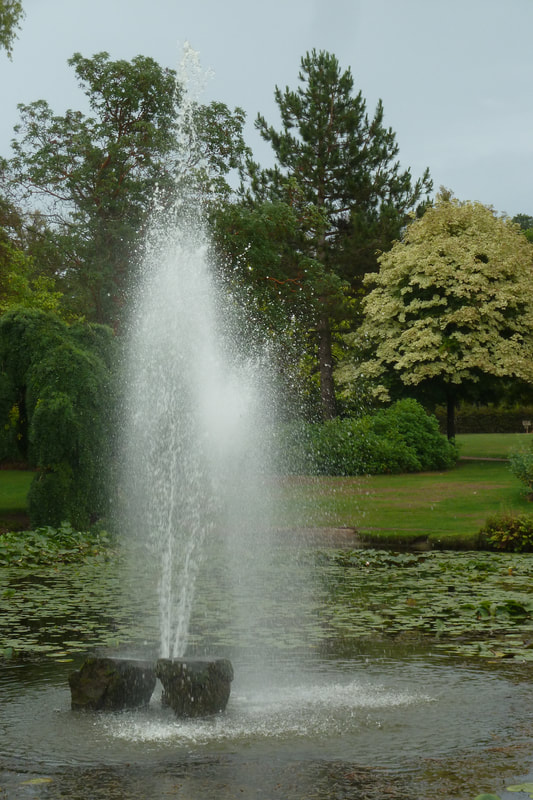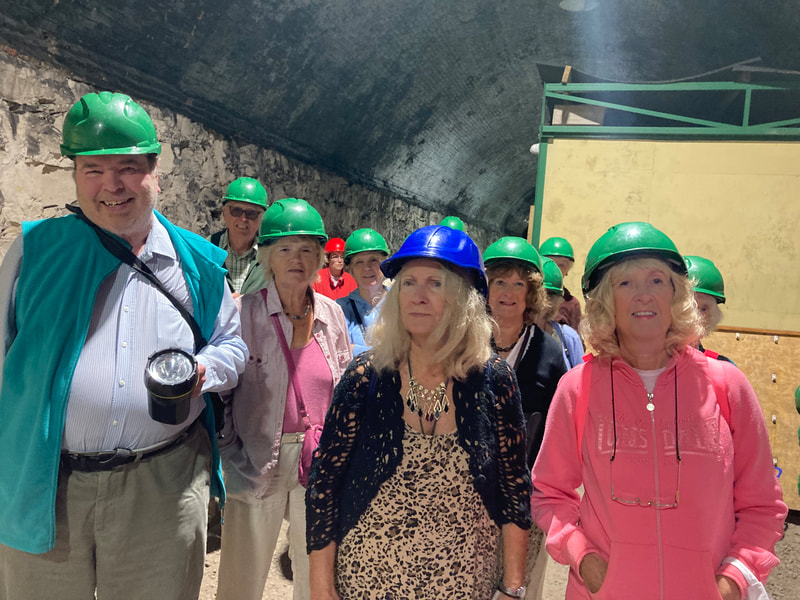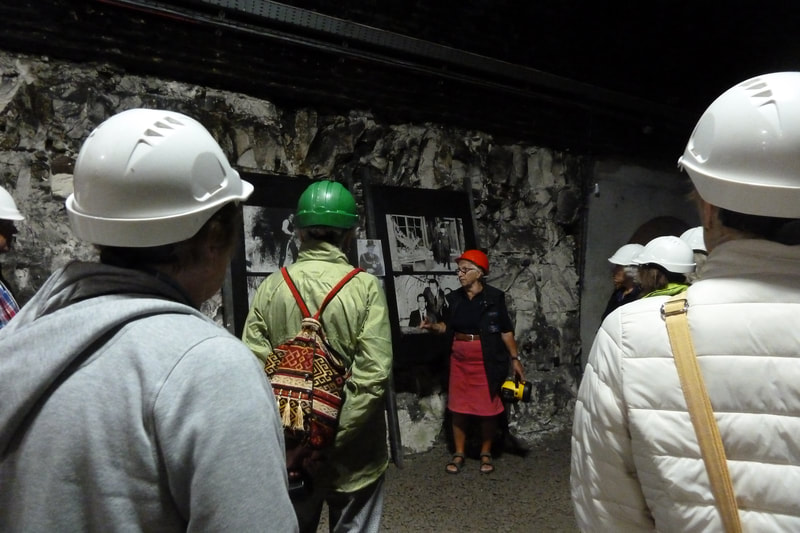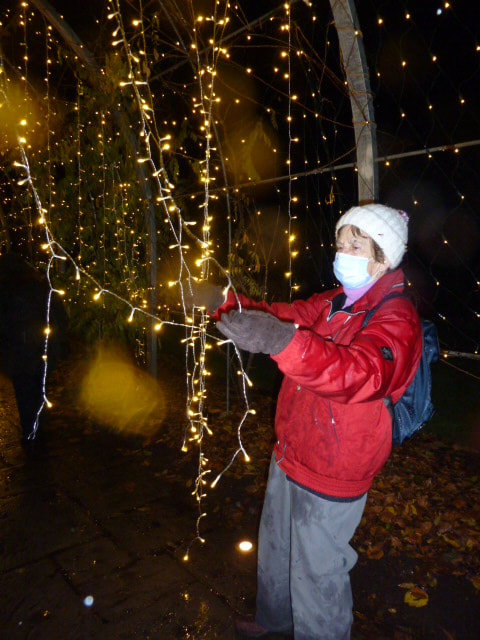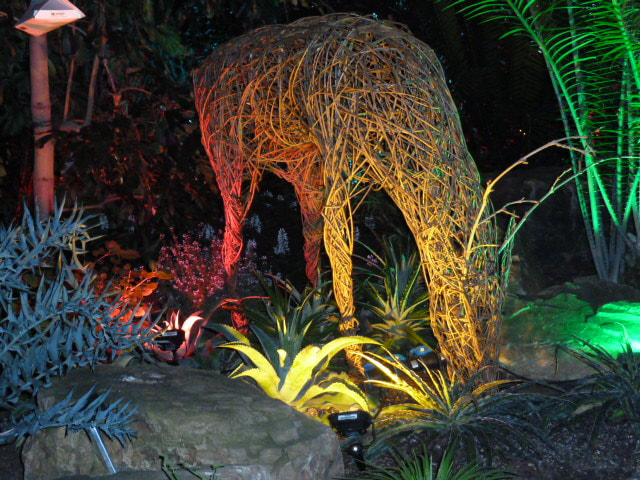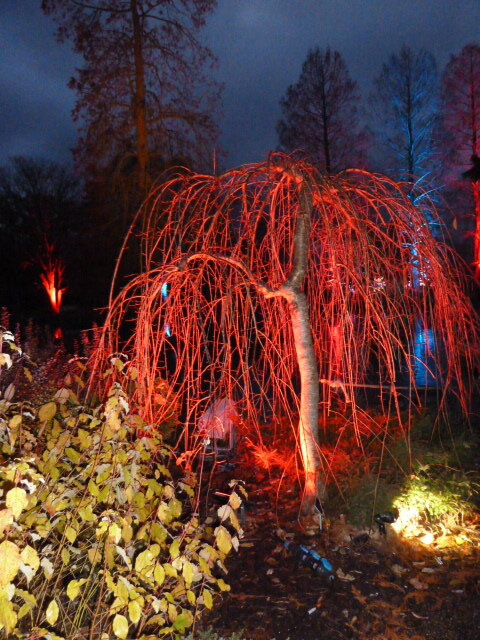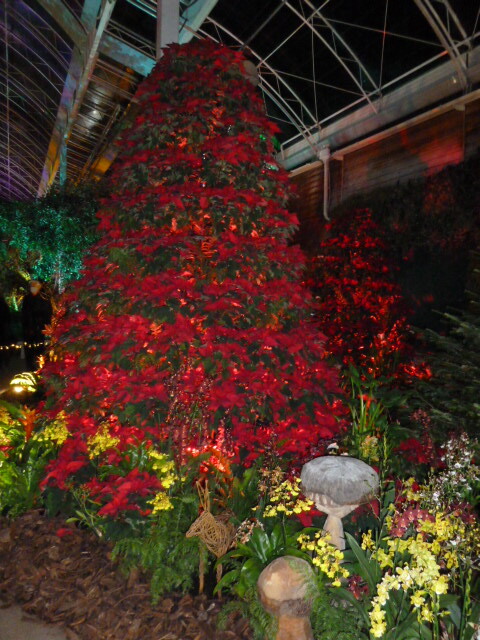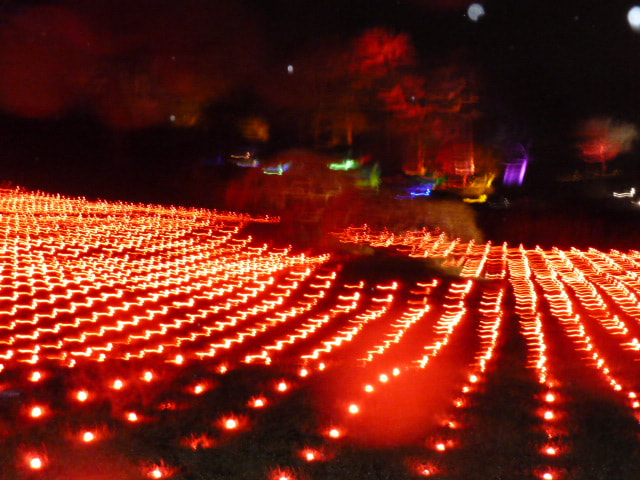OUTINGS
Our preferred method of payment for Outings is by bank transfer (BACS). Click here for a guide. Cheques are also acceptable.
Outing News June2024
Our visit to Chichester flower festival on Wednesday 5th June is full . The July trip to Blenheim Palace on Tuesday 2nd July , at the time of writing had 4 places available , please contact Joan on 0750 4919081 or look at Mays newsletter for the application details.
A review of our visit to Brooklands museum and Concorde experience in May follows the outing news.
In August we have a delightful National Trust visit to Hinton Ampner on Wednesday 7th August .
Hinton Ampner is a home developed over centuries by many different owners . From humble beginnings as a Tudor farmhouse to the lavish influences of the neo -Georgian period, they each brought their different styles. Discover where to look for clues that point to its long and varied history, one that stretches back nearly 500 years. They have a cafe facility for hot and cold drinks and light meals , plus a gift and second hand book shop on site.
The application form for this trip will be in June’s newsletter.
Joan Young
Outings Coordinator
A review of our visit to Brooklands museum and Concorde experience in May follows the outing news.
In August we have a delightful National Trust visit to Hinton Ampner on Wednesday 7th August .
Hinton Ampner is a home developed over centuries by many different owners . From humble beginnings as a Tudor farmhouse to the lavish influences of the neo -Georgian period, they each brought their different styles. Discover where to look for clues that point to its long and varied history, one that stretches back nearly 500 years. They have a cafe facility for hot and cold drinks and light meals , plus a gift and second hand book shop on site.
The application form for this trip will be in June’s newsletter.
Joan Young
Outings Coordinator
Report on the May Outing to Brooklands
On a dull 22nd May, 42 members set off for a day at Brooklands Museum near Weybridge. The rain had started by the time of our arrival but we had come prepared with macs and brollies. First stop coffee to peruse the site map to plan visits to the various buildings housing vintage bicycles, motorcycles, cars, buses and aircraft.
Brooklands the first racing circuit to be opened 1907 held the inaugural British Grand Prix in 1926. Early cars we saw on display came in amazing variety of size, horsepower and design including
Aston Martin, Bugatti, Cooper Climax, Mercedes, McLaren etc, much larger than the later racing cars driven but Ayton Senna, Stirling Moss and Graham Hill.
The range of vintage motorcycles brought back memories of those ridden by our grandfathers and fathers - Norton, AJS, Francis Barnett .
The London Bus museum took us through 150 years of transport in the Capital from horse-drawn, the hop on /hop off bus to the modern two-door, all saved from ending up in the scrap yard.
More than 18000 aircraft were built at Brooklands from the early days of flight to the Hawker Hurricane, Sopwith Camel, Vickers Wellington, military aircraft during WWI and WWII culminating in the introduction of parts for Concorde . There are many types of planes to be seen in the Factory and Flight Shed.
Other displays around the site included workshops, engines, weapons and missiles. Later in the afternoon, we boarded an airport bus to learn the background of the development of Concorde in collaboration with the French. Our visit ended with a virtual flight on Concorde taking off, reaching Mach 2 and landing safely!
A most enjoyable day, thank you Joan, despite the weather.
Chris Hyder
Brooklands the first racing circuit to be opened 1907 held the inaugural British Grand Prix in 1926. Early cars we saw on display came in amazing variety of size, horsepower and design including
Aston Martin, Bugatti, Cooper Climax, Mercedes, McLaren etc, much larger than the later racing cars driven but Ayton Senna, Stirling Moss and Graham Hill.
The range of vintage motorcycles brought back memories of those ridden by our grandfathers and fathers - Norton, AJS, Francis Barnett .
The London Bus museum took us through 150 years of transport in the Capital from horse-drawn, the hop on /hop off bus to the modern two-door, all saved from ending up in the scrap yard.
More than 18000 aircraft were built at Brooklands from the early days of flight to the Hawker Hurricane, Sopwith Camel, Vickers Wellington, military aircraft during WWI and WWII culminating in the introduction of parts for Concorde . There are many types of planes to be seen in the Factory and Flight Shed.
Other displays around the site included workshops, engines, weapons and missiles. Later in the afternoon, we boarded an airport bus to learn the background of the development of Concorde in collaboration with the French. Our visit ended with a virtual flight on Concorde taking off, reaching Mach 2 and landing safely!
A most enjoyable day, thank you Joan, despite the weather.
Chris Hyder
Report on the April Outing to Basildon Park
On a rare sunny day in April, we made our way to Basildon park near Pangbourne in Berkshire. Having been squeezed out of having a visit last year due to the filming of The Crown, our very trusty driver squeezed our coach with only 3 inches to spare through the gates of Basildon Park to a great big cheer from all on board.
We were delighted to see the beautiful home which lay ahead. The
architect John Carr built this wonderful Bath Stone Building. Many of the 1950 restorations carried out by Lord and Lady Liffe and the dressing with fine antiques and paintings gave a real feel for how life was back then, and some of us on the trip clearly remembered some of the kitchen items.
My own favourite was the Shell Room which you will see in some of the photos were just amazing. The dining room was laid out as it was filmed in Downton Abbey. Some other which were filmed there were Pride and Prejudice 2005, Belgravia 2020, Dorian Gray 2009, and The Gentleman 2019.
We were lucky to have a nice dry day to enjoy the 400 acres of gardens and be able to sit out in the courtyard to enjoy the light meals. Our trusty driver got us back home safe and well at 5.30 from a very enjoyable day.
We were delighted to see the beautiful home which lay ahead. The
architect John Carr built this wonderful Bath Stone Building. Many of the 1950 restorations carried out by Lord and Lady Liffe and the dressing with fine antiques and paintings gave a real feel for how life was back then, and some of us on the trip clearly remembered some of the kitchen items.
My own favourite was the Shell Room which you will see in some of the photos were just amazing. The dining room was laid out as it was filmed in Downton Abbey. Some other which were filmed there were Pride and Prejudice 2005, Belgravia 2020, Dorian Gray 2009, and The Gentleman 2019.
We were lucky to have a nice dry day to enjoy the 400 acres of gardens and be able to sit out in the courtyard to enjoy the light meals. Our trusty driver got us back home safe and well at 5.30 from a very enjoyable day.
|
|
Report on the March outing to Borde Hill Gardens
Despite the dreary forecast and persistent rain, 41 stalwart members boarded the coach for a visit to Borde Hill Gardens, set in an Area of Outstanding Natural Beauty overlooking the High Weald.
We were all suitably attired to walk the winding pathways between early magnolias, rhododendrons, camellias and cherry blossoms. Underplanted along the way were a colourful variety of hellebores, crocuses and daffodils. Primroses grew between rocky walls and pavers. Canopies of evergreen trees were mixed amongst those still bare with branches hanging with lovely lichens.
While watching rain dancing off the pond in the Italian Garden, I was assured it looked stunning in the sun and the well-mulched Rose Garden will be sure to produce beautiful blooms in summer.
It was disappointing to find the new Coffee Shop not yet open but we were able to purchase refreshments in the Gardener’s Rest with covered seating across the gardens in a marquee. A variety of gifts and local produce was available in the Gift Shop but no one appeared to be tempted with the very wet plant sales!
Needless to say, the rain eased as we boarded the coach for home but a day in the fresh air with friends is always an enjoyable event. A lovely garden, well worth another visit through the seasons. Thank you very much, Joan, for organising yet another good day out.
Chris Hyder
We were all suitably attired to walk the winding pathways between early magnolias, rhododendrons, camellias and cherry blossoms. Underplanted along the way were a colourful variety of hellebores, crocuses and daffodils. Primroses grew between rocky walls and pavers. Canopies of evergreen trees were mixed amongst those still bare with branches hanging with lovely lichens.
While watching rain dancing off the pond in the Italian Garden, I was assured it looked stunning in the sun and the well-mulched Rose Garden will be sure to produce beautiful blooms in summer.
It was disappointing to find the new Coffee Shop not yet open but we were able to purchase refreshments in the Gardener’s Rest with covered seating across the gardens in a marquee. A variety of gifts and local produce was available in the Gift Shop but no one appeared to be tempted with the very wet plant sales!
Needless to say, the rain eased as we boarded the coach for home but a day in the fresh air with friends is always an enjoyable event. A lovely garden, well worth another visit through the seasons. Thank you very much, Joan, for organising yet another good day out.
Chris Hyder
Report on the Christmas Outing
Report on the October outing to Wrest Park
For over 600 years, the Wrest estate was home to one of the leading aristocratic families in the country, the de Greys. Each generation left its mark on the estate.
The family reached its greatest prominence when Edward IV made Edmund Grey his Lord Treasurer in 1463 and then Earl of Kent in 1465. More than 200 years later, the formal gardens and the canal known as the Long Water were created by Amabel Benn, together with her son, Anthony, the 11th Earl, and his wife, Mary.
In the early 18th century, Anthony’s son, Henry, Duke of Kent (1671–1740), laid out what is now Wrest’s most exceptional feature, its massive formal woodland garden, enclosed on three sides by canals. He employed leading architects and garden designers – including Nicholas Hawksmoor, Thomas Archer, Batty Langley and William Kent – to create an ordered landscape of woodland avenues ornamented with statuary and garden buildings. These included Thomas Archer’s baroque pavilion, with its trompe l’œil paintings by Mark Anthony Hauduroy.
On the duke’s death, his granddaughter Jemima, Marchioness Grey (1723–97), inherited the estate. She showed a keen interest in the gardens. In 1758 she brought in ‘Capability’ Brown, a leader of the new English landscape style of the time, to soften the edges of the garden and remodel the park, while preserving the heart of the formal layout. Brown himself realised that to do more ‘might unravel the Mystery of the Gardens’.
Brown’s work is commemorated by the ‘Capability’ Brown column, built for Jemima by Edward Stevens. Jemima also added a Chinese temple and bridge, the Mithraic altar, and a bath house.
The manor house was crumbling and, rather than making improvements to the old house, the second Earl de Grey, an accomplished amateur architect, demolished it and between 1834 and 1839 built a new house some 200 metres to the north.
Unusually for the time, he chose to adopt an 18th-century French style of architecture both inside and outside the house, perhaps inspired by the estate’s formal gardens. Earlier he had a new gate and lodges built at the Silsoe entrance to the estate, also in the French style.
When it came to the gardens, Earl de Grey showed great respect for the legacy of his forebears. Wrest was sold on 1917 as there was no heir to inherit. English Heritage took over the house in 2006 and began an ambitious 20-year project to restore the gardens to their pre-1917 state. The house is used for administration and for functions, but some of ground floor rooms that are unfurnished are open to the public, so that one can have some idea of the grandeur of the house in its heyday.
Although it was overcast when we left for Bedfordshire and there was a light shower on arrival ,the sun did eventually shine. We all enjoyed exploring the house, formal gardens and woodland, not to mention the café, gift shop, and second-hand bookshop! Very many thanks to Joan Young for organising such a great outing.
Report by Helen Sanders
The family reached its greatest prominence when Edward IV made Edmund Grey his Lord Treasurer in 1463 and then Earl of Kent in 1465. More than 200 years later, the formal gardens and the canal known as the Long Water were created by Amabel Benn, together with her son, Anthony, the 11th Earl, and his wife, Mary.
In the early 18th century, Anthony’s son, Henry, Duke of Kent (1671–1740), laid out what is now Wrest’s most exceptional feature, its massive formal woodland garden, enclosed on three sides by canals. He employed leading architects and garden designers – including Nicholas Hawksmoor, Thomas Archer, Batty Langley and William Kent – to create an ordered landscape of woodland avenues ornamented with statuary and garden buildings. These included Thomas Archer’s baroque pavilion, with its trompe l’œil paintings by Mark Anthony Hauduroy.
On the duke’s death, his granddaughter Jemima, Marchioness Grey (1723–97), inherited the estate. She showed a keen interest in the gardens. In 1758 she brought in ‘Capability’ Brown, a leader of the new English landscape style of the time, to soften the edges of the garden and remodel the park, while preserving the heart of the formal layout. Brown himself realised that to do more ‘might unravel the Mystery of the Gardens’.
Brown’s work is commemorated by the ‘Capability’ Brown column, built for Jemima by Edward Stevens. Jemima also added a Chinese temple and bridge, the Mithraic altar, and a bath house.
The manor house was crumbling and, rather than making improvements to the old house, the second Earl de Grey, an accomplished amateur architect, demolished it and between 1834 and 1839 built a new house some 200 metres to the north.
Unusually for the time, he chose to adopt an 18th-century French style of architecture both inside and outside the house, perhaps inspired by the estate’s formal gardens. Earlier he had a new gate and lodges built at the Silsoe entrance to the estate, also in the French style.
When it came to the gardens, Earl de Grey showed great respect for the legacy of his forebears. Wrest was sold on 1917 as there was no heir to inherit. English Heritage took over the house in 2006 and began an ambitious 20-year project to restore the gardens to their pre-1917 state. The house is used for administration and for functions, but some of ground floor rooms that are unfurnished are open to the public, so that one can have some idea of the grandeur of the house in its heyday.
Although it was overcast when we left for Bedfordshire and there was a light shower on arrival ,the sun did eventually shine. We all enjoyed exploring the house, formal gardens and woodland, not to mention the café, gift shop, and second-hand bookshop! Very many thanks to Joan Young for organising such a great outing.
Report by Helen Sanders
Report on the September outing to Hampton Court
One of the main concerns of Outing Organisers is whether it will rain on the day. There were no worries on the day of our outing, the sun shone all day long, with a record temperature for September of 30+ C.
We alighted from the coach for a walk across Hampton Court Bridge, which afforded a wonderful view of the river, and from there we were in for a treat. It is a most impressive Palace, which today is still owned by the reigning monarch. Originally built by Cardinal Wolsey in the early 16th century, it attracted the attention of Henry VIII, who brought all his six wives there. Indeed, Jane Seymour died there, after giving birth. In the 1700’s, William III and Mary II commissioned Sir Christopher Wren to build an elegant new Palace. Fortunately he chose to leave Henry’s apartments and the chapel intact – where today, as you stroll through, you can sense the hand of history.
In 1838, Queen Victoria opened the Palace to the public and it soon became a major tourist attraction, as it still is today. There is such a wealth of architecture from different ages, and treasures, paintings, jewellery, costumes etc., that it is hard know of which to make special mention. However, about ten years ago a replica was made of the crown worn by King Henry VIII and his children. It was thought that the original had been melted down ….. and recycled…… by the orders of Cromwell, after the execution of Charles I. The replica, which is now on display in the Royal Pew overlooking the Chapel, was made in part by Tunbridge Wells’ jeweller, Harry Collins.
Fortunately, it was fairly cool inside the Palace and so members tended to linger there rather than explore the extensive gardens and famous Maze. It was a pleasant walk, though, to the Tiltyard Café, with jousting horsemen depicted along the wall. Here towards the end of our visit, many of us enjoyed a cold drink or ice cream – supplies of which were running low.
Our thanks to Lorna Jones for this lovely day out and for all the other outings that she has organised. Sadly, Lorna is stepping down from the Outings Committee. We will miss her.
Report byPat Micklewright
We alighted from the coach for a walk across Hampton Court Bridge, which afforded a wonderful view of the river, and from there we were in for a treat. It is a most impressive Palace, which today is still owned by the reigning monarch. Originally built by Cardinal Wolsey in the early 16th century, it attracted the attention of Henry VIII, who brought all his six wives there. Indeed, Jane Seymour died there, after giving birth. In the 1700’s, William III and Mary II commissioned Sir Christopher Wren to build an elegant new Palace. Fortunately he chose to leave Henry’s apartments and the chapel intact – where today, as you stroll through, you can sense the hand of history.
In 1838, Queen Victoria opened the Palace to the public and it soon became a major tourist attraction, as it still is today. There is such a wealth of architecture from different ages, and treasures, paintings, jewellery, costumes etc., that it is hard know of which to make special mention. However, about ten years ago a replica was made of the crown worn by King Henry VIII and his children. It was thought that the original had been melted down ….. and recycled…… by the orders of Cromwell, after the execution of Charles I. The replica, which is now on display in the Royal Pew overlooking the Chapel, was made in part by Tunbridge Wells’ jeweller, Harry Collins.
Fortunately, it was fairly cool inside the Palace and so members tended to linger there rather than explore the extensive gardens and famous Maze. It was a pleasant walk, though, to the Tiltyard Café, with jousting horsemen depicted along the wall. Here towards the end of our visit, many of us enjoyed a cold drink or ice cream – supplies of which were running low.
Our thanks to Lorna Jones for this lovely day out and for all the other outings that she has organised. Sadly, Lorna is stepping down from the Outings Committee. We will miss her.
Report byPat Micklewright
Report on the August Outing to the Rural Life Living Museum
The museum was founded by Henry and Madge Jackson who, realising agricultural implements used by previous generations were being lost and destroyed, visited farm sales and local auctions determined to save these historic artefacts. It is set in 10 acres of open space and woodland. Interesting exhibits included a Shepherds Hut, which was equipped with a wood stove to keep the young lambs nice and warm, the Easing Chapel, where services were held until 1870, the Lindford Village Hall, a cricket pavilion and a schoolroom built around 1900 which was in use for many years until it was damaged in the 1987 hurricane.
A fully furnished pre-fabricated home was of particular interest as these could be erected after the Second World War to solve the acute housing shortage. At the time they were the height of luxury, with big windows, a fitted kitchen, an indoor toilet and even central heating.
In the Tilford building there were many shops that would have traditionally been found in a village, a bakery, cobbler’s shop to make and repair shoes, a haberdashery, a wheelwright shop and many agricultural vehicles.
The Tweedsmuir Camp was built in 1941 by the Royal Canadian Engineers and in 1947 became the living quarters for the Polish Resettlement Corps and housed 80 Polish families, who were invited to settle in Britain after the war.
The Anderson Shelter could accommodate up to six people and was made from galvanised metal, sandbags and a roof covered with earth, and provided protection during bombing raids in the Second World War.
Henry’s Yard was the site of the original museum and exhibited an iron furnace, blacksmith’s forge and domestic interiors room from both the Victorian age and 1930s. The Frensham Building housed a threshing machine, stationary engines, forestry equipment and a couple of manual fire engines.
All in all a very interesting visit which brought up many memories of the past.
Report by Pam Booty
Report on the Outing to Knebworth House
What a place! There was so much to see and enjoy at Knebworth, it is difficult to pick out the highlights. Built in 1490 as a family home, it has been in the same family ever since. When Edward Bulwer Lytton became the owner in 1843, he decided to clad the Tudor brick, adding turrets, gargoyles, and many other features to create the Gothic masterpiece seen today. This has been used in many Hollywood films including being the original Batman Castle. Edward was an author and compatriot of Dickens, and in his day, outsold him. He was also a lover of drama and the interior does not disappoint.
The grand Banqueting Hall has paintings of many of the previous owners. The Dining Room is laid with crestechina and Venetian glassware, also bearing the family crest, and the ceiling is painted with the various Coats of Arms of different generations. Edward’s library is equally magnificent with hidden doors, only given away by the ubiquitous Fire Escape sign. Edward’s love of the fantastical is visible throughout the house including Queen Elizabeth I’s bedroom though this, like many of the fitments he brought in, is a fake. There is no doubt the Queen did stay here – but not in that particular bedroom.
It should rightly be called Winston Churchill’s bedroom, or perhaps Mick Jagger’s or even Olivia Coleman’s as they have all slept here. Olivia because part of The Crown was filmed here, and Jagger because the Stones were one of the many bands to hold a Music Festival in the grounds.
Report and Photos by Janie Ramsay
The grand Banqueting Hall has paintings of many of the previous owners. The Dining Room is laid with crestechina and Venetian glassware, also bearing the family crest, and the ceiling is painted with the various Coats of Arms of different generations. Edward’s library is equally magnificent with hidden doors, only given away by the ubiquitous Fire Escape sign. Edward’s love of the fantastical is visible throughout the house including Queen Elizabeth I’s bedroom though this, like many of the fitments he brought in, is a fake. There is no doubt the Queen did stay here – but not in that particular bedroom.
It should rightly be called Winston Churchill’s bedroom, or perhaps Mick Jagger’s or even Olivia Coleman’s as they have all slept here. Olivia because part of The Crown was filmed here, and Jagger because the Stones were one of the many bands to hold a Music Festival in the grounds.
Report and Photos by Janie Ramsay
Report on the June Outing to Wakehurst Place and Sheffield Park
Two for the Price of One
And weren’t they lovely? The weather warmed up for the afternoon and both Wakehurst Place and Sheffield Park were looking great. Our group of 35 divided in two at Wakehurst and both (volunteer) guides were very knowledgeable and all agreed that we gained so much more with information such as ‘this tree was the only one to survive Hiroshima’ or ‘this one grew to its present considerable height in only sixty years’. The latin names were a little daunting for some but fortunately the threatened test did not materialise! After lunch – whether in the cafe or a picnic in the grounds - we had time for a quick visit to the seed bank, walled garden or the tempting plant sales.
We then headed for Sheffield Park – the lakeside walks were beautiful, water lilies and geese with goslings were among the treats – many rhododendrons were still at their best. Many of us succumbed to ice-creams and/or tea and cake in the cafe, a visit to the second-hand bookshop, more plant sales and then as Andy Pandy used to say ‘time to go home’.
We arrived back in Tunbridge Wells shortly after 6.0 after a most enjoyable day.
Lorna Jones
And weren’t they lovely? The weather warmed up for the afternoon and both Wakehurst Place and Sheffield Park were looking great. Our group of 35 divided in two at Wakehurst and both (volunteer) guides were very knowledgeable and all agreed that we gained so much more with information such as ‘this tree was the only one to survive Hiroshima’ or ‘this one grew to its present considerable height in only sixty years’. The latin names were a little daunting for some but fortunately the threatened test did not materialise! After lunch – whether in the cafe or a picnic in the grounds - we had time for a quick visit to the seed bank, walled garden or the tempting plant sales.
We then headed for Sheffield Park – the lakeside walks were beautiful, water lilies and geese with goslings were among the treats – many rhododendrons were still at their best. Many of us succumbed to ice-creams and/or tea and cake in the cafe, a visit to the second-hand bookshop, more plant sales and then as Andy Pandy used to say ‘time to go home’.
We arrived back in Tunbridge Wells shortly after 6.0 after a most enjoyable day.
Lorna Jones
Report on May's Outing to The Vyne
The five-hundred-year old history of The Vyne is a tale of two families, the Sandys and the Chutes.
The exterior of the house presents a traditional red brick Tudor façade with chimney pots. However, superimposed on the front, is an imposing classical portico. Inside the contrasts continued with the Oak Gallery lined with linenfold panelling; the tapestries keeping out the cold; the carved wooden pews and Renaissance stained glass in the chapel; all reflecting the Tudor period before giving way to the gleaming white Stone Gallery and the sweeping marble of the magnificent classical staircase soaring up to the first floor.
Sir William Sandys inherited the Vyne in 1497 transforming it into one of the most important houses in the country. But by 1601 the 3rd Lord Sandys backed a failed rebellion by the Earl of Essex and ended in the tower. The family were impoverished and the house became damp and dilapidated. The Sandys were forced to sell to Chaloner Chute in 1653 and a new era began. The Chute family furnished it with antiques and artefacts from their grand tours and made the huge structural changes we see today.
Sometimes prospering and sometimes falling into disrepair the old house survived the turbulence of the Tudor period, the Civil, First and Second World Wars and even the occupation of 60 small boys evacuated from a school in Kent during the Second World War. The food was awful and the house freezing but the boys apparently loved the Vyne and its grounds where they swam in the lake and played in the woods. However, in 1956 with no heir, Chaloner William Chute gifted the estate to the National Trust and the tale of two families finally came to an end.
The exterior of the house presents a traditional red brick Tudor façade with chimney pots. However, superimposed on the front, is an imposing classical portico. Inside the contrasts continued with the Oak Gallery lined with linenfold panelling; the tapestries keeping out the cold; the carved wooden pews and Renaissance stained glass in the chapel; all reflecting the Tudor period before giving way to the gleaming white Stone Gallery and the sweeping marble of the magnificent classical staircase soaring up to the first floor.
Sir William Sandys inherited the Vyne in 1497 transforming it into one of the most important houses in the country. But by 1601 the 3rd Lord Sandys backed a failed rebellion by the Earl of Essex and ended in the tower. The family were impoverished and the house became damp and dilapidated. The Sandys were forced to sell to Chaloner Chute in 1653 and a new era began. The Chute family furnished it with antiques and artefacts from their grand tours and made the huge structural changes we see today.
Sometimes prospering and sometimes falling into disrepair the old house survived the turbulence of the Tudor period, the Civil, First and Second World Wars and even the occupation of 60 small boys evacuated from a school in Kent during the Second World War. The food was awful and the house freezing but the boys apparently loved the Vyne and its grounds where they swam in the lake and played in the woods. However, in 1956 with no heir, Chaloner William Chute gifted the estate to the National Trust and the tale of two families finally came to an end.
Some Photos of The Vyne
Report on April's outing to Greys Court
Following the cancellation of the planned visit to Basildon Park we were so fortunate to have Greys Court as a replacement.
The house is no stately pile but a really welcoming house set amongst rolling countryside. From the moment you walked through the doors you were reminded it had been the home of four lively boys, the children of Sir Felix and Lady Elizabeth Brunner, who bought the house in 1937 and bequeathed it to the National Trust in 1969.
Every room felt lived in. The sitting rooms furnished with squashy sofas and welcoming fireplaces, the bedrooms full of 1930s comfort and even the kitchen was light and airy with a member of staff baking biscuits which permeated the house with a delicious aroma! And all the rooms had wonderful views.
Through the centuries the house has been the home to Richard the Third, Lettice Knollys who secretly married Queen Elizabeth’s favourite, Robert Dudley, Peter Fleming, brother of Ian Fleming and so many more.
The present house dates from Tudor times but the first manor was built on land bequeathed to the de Grey family in the 11th century hence the name Greys Court. The ruins of the fortified manor are situated close to the house guarding the entrance to the walled gardens which are reached through an arch and parts are still enclosed by the original curtain wall. Each bite sized garden morphs seamlessly from one arch to the next. The white garden, cherry garden, rose garden, kitchen garden and orchard each lovely in its own way.
We were there for the daffodils and spring bulbs but my personal favourite had to be the cherry blossom avenue a vista of thick white blossoms echoing Houseman’s “cherry hung with snow”.
A really lovely day.
Report by Sheila Casey
The house is no stately pile but a really welcoming house set amongst rolling countryside. From the moment you walked through the doors you were reminded it had been the home of four lively boys, the children of Sir Felix and Lady Elizabeth Brunner, who bought the house in 1937 and bequeathed it to the National Trust in 1969.
Every room felt lived in. The sitting rooms furnished with squashy sofas and welcoming fireplaces, the bedrooms full of 1930s comfort and even the kitchen was light and airy with a member of staff baking biscuits which permeated the house with a delicious aroma! And all the rooms had wonderful views.
Through the centuries the house has been the home to Richard the Third, Lettice Knollys who secretly married Queen Elizabeth’s favourite, Robert Dudley, Peter Fleming, brother of Ian Fleming and so many more.
The present house dates from Tudor times but the first manor was built on land bequeathed to the de Grey family in the 11th century hence the name Greys Court. The ruins of the fortified manor are situated close to the house guarding the entrance to the walled gardens which are reached through an arch and parts are still enclosed by the original curtain wall. Each bite sized garden morphs seamlessly from one arch to the next. The white garden, cherry garden, rose garden, kitchen garden and orchard each lovely in its own way.
We were there for the daffodils and spring bulbs but my personal favourite had to be the cherry blossom avenue a vista of thick white blossoms echoing Houseman’s “cherry hung with snow”.
A really lovely day.
Report by Sheila Casey
Report on December's Trip to the Illuminated Trail at Bedgebury Pinetum
Our coach for this excursion left Tunbridge Wells at 3pm just as the light was fading. The Visitor Centre / café was our first port of call and introduced us to things to come. The view overlooking the lake to the “Fire Garden” installation was spectacular, hundreds of flickering golden flames lit up the night sky.
The “trail” started from the Visitor Centre and meandered through a landscape of trees clothed by the lights in shades of purple and gold, pinks and greens. The changing colours created an illusion that the trees were swaying in time to the music. Foot tapping was the order of the day with every installation along the trail accompanied by syncopated music.
Here and there strategically placed kiosks offered marshmallows for the children to toast and mulled wine for everyone else. The “dancing” trees reflected in the waters of the lake, the drama of the fire garden, the huge silver moon and stars created on the ground and above all the soaring strains of “O Holy Night” as we walked through the tunnel of light were truly magical.
A special thank you has to be given to Sandra Chandnani for not only organising this final outing of the year, a perfect lead up to Christmas, but also for bravely helping our driver on the way home by setting off, torch in hand, to walk ahead of the coach down a very dark country lane to warn the stream of cars coming towards us to cling to the side of the road in order to allow our coach through. Over and above the call of duty!
Report by Sheila Casey
The “trail” started from the Visitor Centre and meandered through a landscape of trees clothed by the lights in shades of purple and gold, pinks and greens. The changing colours created an illusion that the trees were swaying in time to the music. Foot tapping was the order of the day with every installation along the trail accompanied by syncopated music.
Here and there strategically placed kiosks offered marshmallows for the children to toast and mulled wine for everyone else. The “dancing” trees reflected in the waters of the lake, the drama of the fire garden, the huge silver moon and stars created on the ground and above all the soaring strains of “O Holy Night” as we walked through the tunnel of light were truly magical.
A special thank you has to be given to Sandra Chandnani for not only organising this final outing of the year, a perfect lead up to Christmas, but also for bravely helping our driver on the way home by setting off, torch in hand, to walk ahead of the coach down a very dark country lane to warn the stream of cars coming towards us to cling to the side of the road in order to allow our coach through. Over and above the call of duty!
Report by Sheila Casey
Report and Pictures from October Outing to Polesden Lacey
William McEwan bought Polesden Lacey as a “party house” for his daughter, Margaret Greville, (Maggie) in 1906.
The Salon glitters in scarlet and gold, full of Maggie’s objet d’art. The L-shaped galleries provide a show case for her eclectic collection of paintings
The gardens are lovely but the piece de resistance is the Long Walk, overlooking a bucolic landscape of wooded hills, pastures dotted with sheep, and an endless sky. It must have provided a perfect promenade for ladies in billowing gowns and gentlemen in top hats.
For our visit we were fortunate in that there were enough volunteers to explain the fascinating back story to its last hostess.
William McEwan made his fortune(s) from trade, primarily brewing and railways. To an aspiring hostess this was a decided disadvantage, but if that were not enough, Maggie was illegitimate. Her mother came from a humble agricultural family and her liaison with William McEwan was so secret that, when she became pregnant, he sent her down to London for the birth. In fact Maggie was 21 before William married her mother.
So, how did this daughter of trade become accepted by High Society and entertain Royalty? Undoubtedly her father’s fortune helped but Maggie also inherited her father’s hard head. She married a minor aristocrat to obtain a title and for his Society connections. She kept firm control of her own fortune. The death of her husband, before his father, meant that her hopes of obtaining a title were dashed but “better a beeress than a peeress” said Maggie and she still made full use of her husband’s connections including cultivating Alice Kepple, Mistress to Edward VII.
Finally, she was immensely practical. She installed a lift at Polesden Lacey and moved the kitchens next to the dining room so the food arrived hot. She had, according to Edward VII, a genius for hospitality, and this little lady of no particular beauty and absolutely no background used that one skill to forge a reputation for making her guests comfortable.She had the money, she had the setting and she used them.
The Salon glitters in scarlet and gold, full of Maggie’s objet d’art. The L-shaped galleries provide a show case for her eclectic collection of paintings
The gardens are lovely but the piece de resistance is the Long Walk, overlooking a bucolic landscape of wooded hills, pastures dotted with sheep, and an endless sky. It must have provided a perfect promenade for ladies in billowing gowns and gentlemen in top hats.
For our visit we were fortunate in that there were enough volunteers to explain the fascinating back story to its last hostess.
William McEwan made his fortune(s) from trade, primarily brewing and railways. To an aspiring hostess this was a decided disadvantage, but if that were not enough, Maggie was illegitimate. Her mother came from a humble agricultural family and her liaison with William McEwan was so secret that, when she became pregnant, he sent her down to London for the birth. In fact Maggie was 21 before William married her mother.
So, how did this daughter of trade become accepted by High Society and entertain Royalty? Undoubtedly her father’s fortune helped but Maggie also inherited her father’s hard head. She married a minor aristocrat to obtain a title and for his Society connections. She kept firm control of her own fortune. The death of her husband, before his father, meant that her hopes of obtaining a title were dashed but “better a beeress than a peeress” said Maggie and she still made full use of her husband’s connections including cultivating Alice Kepple, Mistress to Edward VII.
Finally, she was immensely practical. She installed a lift at Polesden Lacey and moved the kitchens next to the dining room so the food arrived hot. She had, according to Edward VII, a genius for hospitality, and this little lady of no particular beauty and absolutely no background used that one skill to forge a reputation for making her guests comfortable.She had the money, she had the setting and she used them.
Report & Pictures from September Outing to Cliveden
Situated on a terrace high above the Thames and designed by Sir Charles Barry, Cliveden is not a cosy house. It exudes power.
Built of harsh white stone, its heavy portico and balustrade dominate the landscape. On the day of our visit the heavens opened but, between the torrential downpours, the views from the terrace were magnificent. The house, although owned by the National Trust, is now a luxurious hotel. We were very fortunate to be guided around the ground floor. The tour included the Great Baronial Hall panelled in English Oak with Corinthian columns and swags of carved flowers. A 16th century fireplace brought from a Bergundian chateau dominates the room. Standing in its shadow is a really lovely portrait of Nancy, Lady Astor, by John Singer Sargent. We were also able to see the French dining room oozing Rococco charm, its 18th century panelling came from the Chateau d’Asnieres near Paris and was once owned by Madame de Pompadour. French loss our gain?
The Astors played host to the great and the good in the 1920s and 30s. But the house is also notorious for its many scandals, famously that of Christine Keeler and John Profumo in the 1950s.
Following our house tour the rain continued to fall and thunder rumbled overhead as we were transported down to the Thames for our included boat trip. The section of the Thames bordering Cliveden is not tidal and the river runs gently past the estate. To the sound of raindrops falling overhead we drifted along the tranquil river.
We finally left Cliveden still shrouded in mist and dark clouds. On the way home we learnt our beloved Queen had died. But towards journeys end the sun came out, just in time to welcome our new King.
Built of harsh white stone, its heavy portico and balustrade dominate the landscape. On the day of our visit the heavens opened but, between the torrential downpours, the views from the terrace were magnificent. The house, although owned by the National Trust, is now a luxurious hotel. We were very fortunate to be guided around the ground floor. The tour included the Great Baronial Hall panelled in English Oak with Corinthian columns and swags of carved flowers. A 16th century fireplace brought from a Bergundian chateau dominates the room. Standing in its shadow is a really lovely portrait of Nancy, Lady Astor, by John Singer Sargent. We were also able to see the French dining room oozing Rococco charm, its 18th century panelling came from the Chateau d’Asnieres near Paris and was once owned by Madame de Pompadour. French loss our gain?
The Astors played host to the great and the good in the 1920s and 30s. But the house is also notorious for its many scandals, famously that of Christine Keeler and John Profumo in the 1950s.
Following our house tour the rain continued to fall and thunder rumbled overhead as we were transported down to the Thames for our included boat trip. The section of the Thames bordering Cliveden is not tidal and the river runs gently past the estate. To the sound of raindrops falling overhead we drifted along the tranquil river.
We finally left Cliveden still shrouded in mist and dark clouds. On the way home we learnt our beloved Queen had died. But towards journeys end the sun came out, just in time to welcome our new King.
Report and Pictures from the August Outing to Ramsgate
Ramsgate Tunnels were constructed at the outbreak of WW2 to provide some of the finest air raid shelters ever built and, nowadays, are certainly well worth visiting. The fact that these tunnels were built at all and completed in record time in 1939 was largely down to the persistence of the flamboyant Mayor and expertise of the Borough Engineer, the mastermind behind three and half miles of chalk tunnels under the town, with eleven entrances at strategic points – able to provide shelter for up to 60,000 people, with over 1,000 permanent residents, whose homes had been destroyed. After the war the tunnels were eventually closed. However, a Trust was formed, Lottery money was secured and the tunnels opened to the public in 2014. We divided into two groups, and equipped with hard hats and large torches, we explored a section of the tunnels with volunteer guides to tell us about the history of their construction, the facilities provided and what it was like for the people who used them during the war. Today, they have replicated some of the living quarters/sleeping areas, so that children can experience a night sleeping there (probably with not much sleep going on!). Afterwards, we had free time to enjoy a glorious, sunny day by the sea, wandering around the beautiful harbour and waterfront. Some of us found our way to Wetherspoons housed in the Royal Victoria Pavilion on the seafront, where one could sit in the open air on the balconies and enjoy a drink and lunch, whilst keeping an eye on a nearby seagull. A long, but lovely day. Thank you, Stella.
(Report by Pat Micklewright)
(Report by Pat Micklewright)
Report on Outing to Leonardslee and Nymans Gardens
Once through the gates of Leonardslee the gardens lay out in front for us to enjoy. Sculptures in and around the grounds were quite spectacular. If, after a walk, your tummy’s rumbling, the café had something for all. Then we visited The Dolls House Museum; a very clever work of art. Back on the coach.
Our next visit was Nymans. Indulgent or what?! Two gardens in one day. I know you wish you had come with us! Nymans has a connection to royalty, being Lord Snowdon’s childhood home. The gardens are full of colour throughout the year and the volunteers were happy to answer any questions you may have. What a super, indulgent day out. Report by Sheila Austin
Once through the gates of Leonardslee the gardens lay out in front for us to enjoy. Sculptures in and around the grounds were quite spectacular. If, after a walk, your tummy’s rumbling, the café had something for all. Then we visited The Dolls House Museum; a very clever work of art. Back on the coach.
Our next visit was Nymans. Indulgent or what?! Two gardens in one day. I know you wish you had come with us! Nymans has a connection to royalty, being Lord Snowdon’s childhood home. The gardens are full of colour throughout the year and the volunteers were happy to answer any questions you may have. What a super, indulgent day out. Report by Sheila Austin
Report on Outing to Hughenden Manor
Well, weren’t we in for a surprise, Lots of them? Benjamin Disraeli moved into Hughenden Manor with his wife Mary Anne. The red brick Victorian manor remained Disraeli’s home until his death in 1881.
A short walk too where he was laid to rest next to his wife, is well worth adding to things to see.
The house sits on a hill with magnificent views. Red Kites soar high above our heads and the beautiful gardens. Hughenden Manor just keeps surprising us. The house is full of them. I am deliberately holding back information regarding our trip, those who were there will understand. We don’t want to spoil the adventure for U3A members who haven’t yet visited. You won’t be disappointed. Disraeli allows us into his inner (not that he has any choice) sanctum, the house is full of interesting facts of his life.
We wandered freely. Guides on hand if needed. The café staff couldn’t do enough to make us welcome. Carts to help navigate any obstacles. Everything and everyone were perfect. You’d have a job to find anything to moan about Hughenden, o there is one thing, ‘the snoring on the way home’. Tee hee.
Happy Days…..
Sheila Austin.
A short walk too where he was laid to rest next to his wife, is well worth adding to things to see.
The house sits on a hill with magnificent views. Red Kites soar high above our heads and the beautiful gardens. Hughenden Manor just keeps surprising us. The house is full of them. I am deliberately holding back information regarding our trip, those who were there will understand. We don’t want to spoil the adventure for U3A members who haven’t yet visited. You won’t be disappointed. Disraeli allows us into his inner (not that he has any choice) sanctum, the house is full of interesting facts of his life.
We wandered freely. Guides on hand if needed. The café staff couldn’t do enough to make us welcome. Carts to help navigate any obstacles. Everything and everyone were perfect. You’d have a job to find anything to moan about Hughenden, o there is one thing, ‘the snoring on the way home’. Tee hee.
Happy Days…..
Sheila Austin.
Visit to the Congress Theatre Eastbourne to see Chicago
On Thursday 17 February our first outing for 2022 took us to Eastbourne to see the musical Chicago at the Congress theatre. The theatre was packed. It was lovely to see so many people determined to go out and about again. As for the show, well Razzle Dazzle girls and all that Jazz! The dancing was eye watering. Perhaps a bit too eye watering for some, but Faye Brooks, playing Roxie Hart, was mesmerising, particularly in the scene where she imitated a puppet having its strings pulled by Liam Marcelino, playing Billy Flynn, her crooked defence lawyer.
Djalenga Scott was equally amazing playing Roxie’s rival Velma Kelly. Djalenga has the longest legs I have ever seen, like Betty Grable’s they should be insured!
The dancing was raunchy, the girls beautiful, the musicians not hidden away in the pit but joining in right up there on the stage.
And at the end of the show, Barry, our coach driver, was parked almost right outside the theatre to take us home.
Report by Joan Young, Outings Coordinator
Report on Outing to Wisley Glow
When our coach set off for the Wisley Glow it was packed. The Glow was scheduled for 4 pm but exceptionally the M25 was not gridlocked and we were early so Barry, our very experienced driver, took us off piste for a detour to Oxshot and a bird’s eye view of the sumptuous mansions favoured, amongst others, by footballers’ wives.
Even so we were still early and had plenty of time for hot chocolate, mulled wine, or whatever took your fancy, before the Glow started.
Finally, darkness fell and we could follow the Glow trail. It rained but that didn’t matter, rather it enhanced the experience, lasers lit up the dark sky turning the raindrops into diamonds, coloured fountains sprung to life shooting up from the lakes, waterfalls thundered and changed colour. We walked through tunnels of light accompanied by classical music, goblets of fire exploded to the foot tapping beat of “New York, New York”. Even the trees appeared to shimmer, and of course there were carols. It was simply stunning a banquet for the senses, and a great way to welcome in Christmas. I loved it. And if that wasn’t enough there was still plenty of time to explore and perhaps buy the lovey goodies in the Christmas shop.
Thank you to Sheila Casey for the report and to Stella Westrup for the photos.
Even so we were still early and had plenty of time for hot chocolate, mulled wine, or whatever took your fancy, before the Glow started.
Finally, darkness fell and we could follow the Glow trail. It rained but that didn’t matter, rather it enhanced the experience, lasers lit up the dark sky turning the raindrops into diamonds, coloured fountains sprung to life shooting up from the lakes, waterfalls thundered and changed colour. We walked through tunnels of light accompanied by classical music, goblets of fire exploded to the foot tapping beat of “New York, New York”. Even the trees appeared to shimmer, and of course there were carols. It was simply stunning a banquet for the senses, and a great way to welcome in Christmas. I loved it. And if that wasn’t enough there was still plenty of time to explore and perhaps buy the lovey goodies in the Christmas shop.
Thank you to Sheila Casey for the report and to Stella Westrup for the photos.


